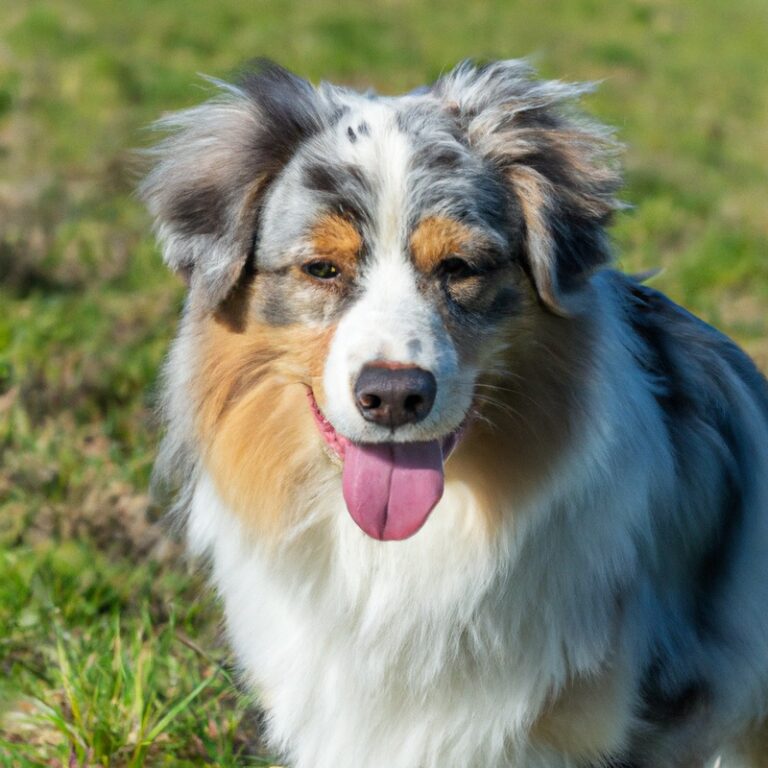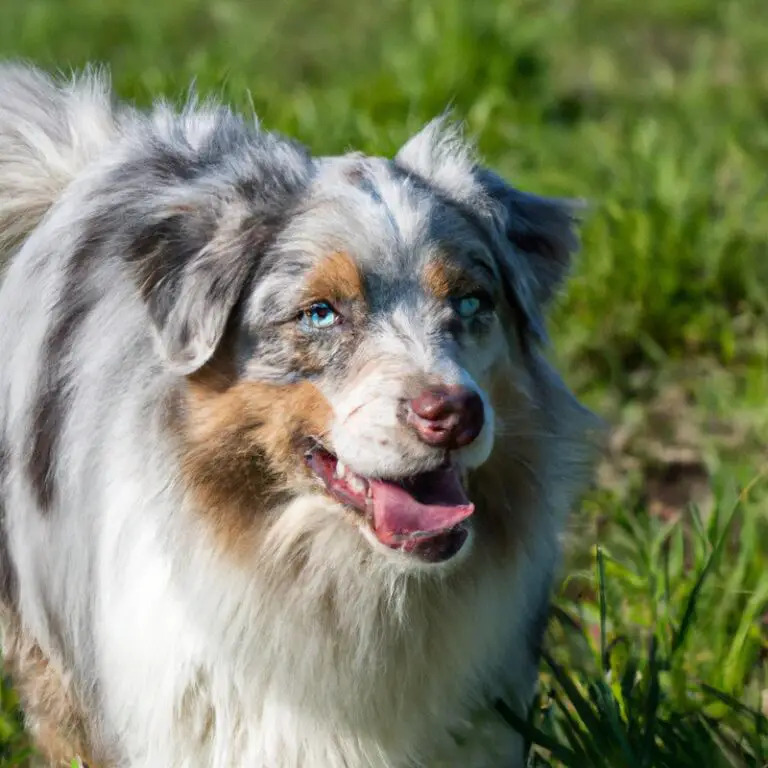How Do Australian Shepherds Behave When Introduced To New Dogs?
Key Takeaways:
- Australian Shepherds generally exhibit friendly behavior when introduced to new dogs.
- They may initially display cautious or reserved behavior, but usually warm up quickly.
- Australian Shepherds are known for their high energy levels and playful nature during initial interactions with new dogs.
- Proper socialization and positive reinforcement can help Australian Shepherds adapt well to new dogs and establish harmonious relationships.
Are you curious about how Australian Shepherds, those lively and intelligent dogs, behave when meeting new furry friends? Well, you’ve come to the right place! As an expert on canine behavior, I’m here to shed some light on the intriguing world of Australian Shepherds and their interactions with other dogs.
In this article, we’ll dive into their general temperament, socialization needs, and the importance of proper introductions.
We’ll also explore typical behaviors they exhibit when meeting new dogs, including signs of aggression, play styles, and communication methods. So, grab a cup of coffee, get comfortable, and let’s embark on this insightful journey together!
Understanding the Behavioral Traits of Australian Shepherds
Overview of Australian Shepherds’ General Temperament
Australian Shepherds have a lively and energetic temperament. They are known for being highly intelligent, agile, and active.
These dogs thrive when they have a job to do or are given tasks that challenge them mentally and physically.
Australian Shepherds are also known to be loyal, affectionate, and eager to please their owners. They form strong bonds with their families and are generally good with children and other pets when properly socialized.
However, due to their herding instincts, they may try to herd small animals or children.
It is important to provide them with plenty of exercise and mental stimulation to prevent boredom and potential behavioral issues. With proper training, socialization, and a loving environment, Australian Shepherds make wonderful companions for active individuals or families.
Socialization Needs of Australian Shepherds
Australian Shepherds have high socialization needs. They thrive on interaction and exposure to different environments, people, and animals.
Socialization helps them develop confidence and positive behavior.
Using positive reinforcement techniques, you can introduce your Australian Shepherd to new dogs and gradually increase their socialization experiences. Consistent, gentle exposure to a variety of situations will help them become well-rounded and adaptable pets.
Remember to provide positive experiences, avoid overwhelming situations, and prioritize their comfort and safety.
Socializing your Australian Shepherd from an early age is essential for their overall well-being and can prevent behavior issues in the future.

Introducing Australian Shepherds to New Dogs
Importance of Proper Introduction and Socialization
Proper introduction and socialization are vital for Australian Shepherds. It helps them develop healthy relationships with other dogs and people, and prevents behavior issues.
When introduced correctly, they learn appropriate behavior and become more confident and adaptable.
Socialization involves exposing them to various environments, sounds, and stimuli while ensuring positive experiences. It is crucial to start socializing them at a young age and continue throughout their lives.
By providing them with positive interactions, we can help them become well-rounded and happy companions.

Tips for a Successful Introduction
When introducing your Australian Shepherd to new dogs, there are a few tips that can help ensure a successful introduction. Here are some things to keep in mind:
- Choose the right environment: Find a neutral location for the introduction, such as a park or a friend’s backyard. This can help reduce any territorial behavior and make the dogs feel more at ease.
- Use positive reinforcement: Reward both dogs with treats and praise for calm and friendly behavior during the introduction. This will help create positive associations and encourage good behavior.
- Start with leashed introductions: Begin by introducing the dogs on leash to maintain control and ensure safety. Allow them to sniff and greet each other while keeping the leashes loose. If all goes well, you can gradually give them more freedom.
- Observe body language: Pay attention to the body language of both dogs. Look for signs of relaxation, such as loose wagging tails and soft body postures. Be alert for any signs of aggression or fear, such as growling, raised hackles, or cowering.
- Take it slow: Allow the dogs to interact at their own pace. Some dogs may quickly become friends, while others may need more time to warm up to each other. Avoid forcing the interaction and give them breaks if needed.
- Arrange supervised playdates: Once the initial introduction goes well, consider arranging supervised playdates with the new dog. This can help build their social skills and strengthen their bond over time.
Remember, every dog is unique, and introductions can vary from dog to dog. It’s important to be patient, observe their behavior, and make adjustments as needed.
If you have any concerns or need more guidance, don’t hesitate to consult with a professional dog trainer or behaviorist.
Recognizing Appropriate Behavior during Introductions
Recognizing appropriate behavior during introductions with new dogs is essential for a smooth and positive interaction. When Australian Shepherds are being introduced to new dogs, there are a few behaviors that indicate a positive response.
First, I look for calm and relaxed body language.
A wagging tail held at a neutral height, loose muscles, and a soft expression are good signs. Ears should be up and forward, showing interest without any signs of aggression or fear.
Second, I observe how they approach the other dog.
Sniffing is a normal way for dogs to gather information, so gentle and relaxed sniffing is a positive behavior. They may also engage in a playful or friendly behavior, such as play bowing or wagging their tail in a friendly manner.
Third, I pay attention to their vocalizations.
Barking or growling during introductions is not typically a positive sign, so it’s best to intervene and redirect their attention before it escalates. Overall, the key is to look for signs of relaxation, interest, and friendliness.
It’s important to remember that each dog is an individual, so their behavior during introductions may vary.
Trust your instincts and always prioritize the safety and well-being of all dogs involved.
Common Behavior of Australian Shepherds when Meeting New Dogs
Australian Shepherds’ Reactivity Levels
Australian Shepherds have varying reactivity levels when meeting new dogs. Some Australian Shepherds may be highly reactive, while others may be more laid back.
It’s important to remember that every dog is an individual, and their reactions can differ based on their genetics, past experiences, and socialization.
While some Australian Shepherds may exhibit aggression or fear towards new dogs, others may show friendliness and excitement. Paying attention to your dog’s body language and ensuring a proper introduction can help set the stage for a positive interaction.

Signs of Aggression and Fear
Signs of Aggression and Fear in Australian Shepherds can manifest in various ways. When meeting new dogs, an aggressive Australian Shepherd may display behaviors such as growling, barking, snapping, lunging, or even biting.
These signs indicate that the dog feels threatened or protective of its territory or resources.
On the other hand, a fearful Australian Shepherd may exhibit trembling, hiding, cowering, or even attempts to escape the situation. It’s important to recognize these signs and react accordingly to prevent any potential conflicts or injuries.
Typical Play Styles and Friendliness
Australian Shepherds have a reputation for being friendly and playful dogs. When meeting new dogs, they often exhibit an energetic and enthusiastic play style.
They love to chase and be chased, so you might see them running around and engaging in lots of zoomies.
They also enjoy wrestling and playing tug-of-war. In terms of friendliness, Australian Shepherds are generally sociable dogs.
They tend to get along well with other dogs and enjoy their company.
They are known to be very affectionate and loyal to their furry friends. However, it’s important to remember that every dog is unique, and individual personalities can vary.
Some Australian Shepherds may be more reserved or cautious when meeting new dogs, especially if they haven’t been properly socialized.
When introducing your Australian Shepherd to a new dog, it’s essential to supervise the interaction and ensure that both dogs are comfortable and enjoying the playtime. Look out for any signs of discomfort or aggression, such as growling, snarling, or stiff body language.
If you notice any negative behavior, it’s best to separate the dogs and try again later in a controlled and supervised environment.
Overall, Australian Shepherds are typically friendly and enjoy playing with other dogs. However, it’s always important to assess each situation and ensure that both dogs are comfortable and safe during their interactions.
Communication Methods with New Dogs
When it comes to communicating with new dogs, Australian Shepherds often rely on body language and vocalizations. They use a variety of signals to express their intentions and emotions.
Here are some common communication methods you may observe:
- Body Language: Australian Shepherds use their body to convey messages. They may exhibit friendly behavior by wagging their tail, approaching with loose, relaxed body posture, and making gentle eye contact. On the other hand, they may display signs of discomfort or avoidance, such as turning their head away, stiffening their body, or raising their hackles.
- Vocalizations: Australian Shepherds may use different vocalizations to communicate with new dogs. They may bark, growl, or even make playful noises, depending on the situation. It’s essential to pay attention to the tone and intensity of their vocalizations to understand their underlying emotions.
- Scent Marking: Australian Shepherds, like many other dogs, use scent marking as a form of communication. They may sniff and mark their territory to leave their scent, which can provide information to other dogs.
- Play Behavior: Australian Shepherds are often playful and may use play behavior to communicate with new dogs. They may initiate play by engaging in bouncy movements, bowing, and offering their front paws. It’s crucial to observe how both dogs react and ensure that the play remains friendly and appropriate.
Remember, every dog is unique, and their communication styles may vary. It’s essential to closely observe and understand your Australian Shepherd’s body language, vocalizations, and play behavior to ensure positive interactions with new dogs.
If you have any concerns or need guidance, don’t hesitate to seek professional help from trainers or behaviorists who specialize in dog communication and socialization.
Challenges and Issues with Australian Shepherds’ Behavior
Possibility of Resource Guarding
Resource guarding is a possible behavior issue that Australian Shepherds may exhibit when introduced to new dogs. This behavior is characterized by the dog becoming possessive and protective over items such as food, toys, or even their favorite spot on the couch.
It is important to address resource guarding early on to prevent any potential conflicts or aggression.
To discourage resource guarding in Australian Shepherds, it is crucial to establish clear rules and boundaries from the beginning. This can be done by implementing positive reinforcement training methods that teach the dog to associate the presence of other dogs with positive experiences.
Gradual desensitization and counterconditioning techniques can be used to help the dog feel relaxed and comfortable when sharing resources.
It is also important to avoid any situations that may trigger resource guarding behavior. This includes keeping valuable resources out of reach and providing separate feeding areas for multiple dogs.
By ensuring that each dog has their own space and belongings, resource guarding can be minimized.
In addition, proper socialization and positive interactions with other dogs are key in preventing resource guarding behavior. Exposing Australian Shepherds to various social situations and teaching them appropriate manners around other dogs can help build their confidence and reduce the likelihood of possessive behaviors.
Overall, being aware of the possibility of resource guarding and taking proactive measures is essential in maintaining harmonious relationships between Australian Shepherds and new dogs.
With the right training, socialization, and understanding, resource guarding can be effectively managed and minimized in Australian Shepherds.
Separation Anxiety and Its Impact
Separation anxiety is a common issue that Australian Shepherds may experience when left alone. This can have a significant impact on their behavior and well-being.
Australian Shepherds are known for their strong bond with their owners, so being separated from them can cause stress and anxiety.
They may exhibit behaviors such as excessive barking, destructive chewing, and even attempts to escape. The impact of separation anxiety can be seen in various aspects of an Australian Shepherd’s life.
It can lead to a decline in their overall behavioral and mental health.
They may become more prone to developing other behavior problems and may have difficulty adjusting to new environments or routines. In addition, separation anxiety can also have an impact on the relationship between the Australian Shepherd and their owner.
The constant worry and stress associated with leaving the dog alone can cause strain on the bond between them.
The owner may feel guilty or frustrated, while the dog may become more clingy or dependent. To address separation anxiety and its impact, it’s important to provide proper training and socialization from an early age.
Gradual desensitization exercises can help the Australian Shepherd become more comfortable with being alone.
Offering plenty of mental stimulation and engaging toys can also help alleviate boredom and anxiety. If the separation anxiety persists or worsens, seeking professional help from a qualified dog trainer or behaviorist is highly recommended.
They can provide tailored strategies and guidance to help manage and overcome the anxiety.
With patience, consistency, and the right approach, separation anxiety in Australian Shepherds can be effectively addressed and minimized.
Dealing with Reactivity and Overexcitement
Dealing with reactivity and overexcitement in Australian Shepherds can be challenging but manageable. One effective approach is to redirect their attention and energy towards more appropriate outlets.
Providing mental stimulation and engaging activities can help minimize these behaviors.
Consistent and positive training methods, such as teaching them self-control and calm behaviors, are also beneficial. It’s important to stay calm and avoid reinforcing reactive or overexcited behaviors.
Seeking professional guidance from a dog trainer or behaviorist can provide valuable insights and strategies tailored to your Australian Shepherd’s specific needs.
With patience, consistency, and proper guidance, you can help your Australian Shepherd learn to manage their reactivity and overexcitement.
Addressing Fear and Insecurity in Social Situations
Addressing fear and insecurity in social situations is essential for the well-being of Australian Shepherds. To help them feel more comfortable, it’s important to create a safe and positive environment.
One way to address fear is through gradual exposure to new dogs, starting with calm and controlled interactions.
Building their confidence through positive reinforcement training can also be beneficial. Patience and understanding are key in helping Australian Shepherds overcome their fears and insecurities.
If necessary, seeking the guidance of a professional trainer can provide additional support and guidance.
Training and Socializing Australian Shepherds from an Early Age
Importance of Obedience Training
Obedience training is incredibly important for Australian Shepherds. It helps establish a strong bond between you and your dog, as well as ensures their safety and the safety of others.
Through obedience training, you can teach your Australian Shepherd basic commands like sit, stay, down, and come.
These commands are not just useful in daily life, but also essential for their safety in potentially dangerous situations. Additionally, obedience training helps to control behavioral issues such as jumping up, excessive barking, and pulling on the leash.
By providing clear guidance and consistent rules, you can help your Australian Shepherd understand what is expected of them and how to behave appropriately in various situations.
Moreover, obedience training promotes mental stimulation and socialization for Australian Shepherds. It gives them the opportunity to interact with other dogs and people, which is crucial for their overall wellbeing and development.
Making Socialization a Priority
Making socialization a priority is key when it comes to raising Australian Shepherds. It helps them develop the necessary skills and behaviors to interact positively with other dogs and people.
When you prioritize socialization, you expose your Australian Shepherd to various environments, sounds, smells, and situations from an early age.
Regularly exposing your Australian Shepherd to new experiences will help them become confident, adaptable, and well-rounded. It’s important to introduce them to different dogs, both familiar and unfamiliar, in controlled and supervised environments.
This will teach them how to interact appropriately and avoid reactive or aggressive behavior.
To make socialization a priority, you can take your Australian Shepherd to puppy classes or group training sessions where they can interact with other dogs and people. Encourage positive experiences and reward them when they exhibit calm and friendly behavior during these interactions.
Regular outings to parks, dog-friendly events, and walks in different neighborhoods will also expose your Australian Shepherd to different sights, sounds, and smells.
This will help them become more comfortable and less fearful in new environments. Remember, socialization should be a lifelong process, not just limited to the puppy stage.
Continually exposing your Australian Shepherd to new people, dogs, and situations will help them maintain their social skills and prevent them from becoming fearful or reactive.
Ultimately, by making socialization a priority, you are setting your Australian Shepherd up for a happy and well-adjusted life, where they can confidently navigate various social situations and enjoy positive interactions with other dogs and people.
Professional Training Assistance for Australian Shepherds
Professional training assistance is vital for Australian Shepherds. Whether you’re dealing with behavior issues or simply want to enhance your dog’s skills, a professional trainer can make a significant difference.
They have the expertise and experience to assess your dog’s needs and develop a customized training plan.
From basic obedience commands to advanced skills, trainers are equipped to teach your Australian Shepherd how to be well-behaved and responsive. Additionally, working with a professional trainer ensures that you understand the most effective training techniques and can continue reinforcing them at home.
Recommendations for Ensuring Positive Interactions
Supervision and Safety Measures
When introducing Australian Shepherds to new dogs, it’s important to prioritize supervision and safety. Here are some key measures to ensure positive interactions:
- Always supervise the initial meetings between your Australian Shepherd and the new dog. This allows you to intervene if any issues arise and prevents potential conflicts.
- Use a leash during introductions to have better control over the situation. It allows you to safely manage any behavioral cues and prevent any possible aggression or misunderstandings.
- Choose a neutral and controlled environment for the first meeting. This can help reduce territorial behavior and promote a more relaxed atmosphere for both dogs.
- Focus on positive reinforcement techniques, rewarding calm and friendly behavior from your Australian Shepherd during these introductions. This encourages their positive association with new dogs.
- If either dog shows signs of aggression or fear, separate them immediately and seek professional help if needed. It’s essential to prioritize the safety and well-being of all dogs involved.
Remember, every dog is unique, and each introduction may have different outcomes. By prioritizing supervision and implementing safety measures, you can help ensure positive interactions and a harmonious relationship between your Australian Shepherd and new dogs.
Providing Adequate Exercise and Mental Stimulation
Providing adequate exercise and mental stimulation is essential for Australian Shepherds’ overall well-being and behavior. These active and intelligent dogs have high energy levels and thrive on regular physical activity.
Engaging them in activities such as long walks, jogging, and interactive play sessions will help release their excess energy and prevent boredom or destructive behavior.
Mental stimulation is equally important; puzzles, obedience training, or interactive toys can keep their minds sharp and prevent behavioral issues. It’s crucial to find a balance between exercise and mental stimulation to help Australian Shepherds lead a happy and well-rounded life.
Seeking Professional Help if Needed
If you’re struggling to introduce your Australian Shepherd to new dogs or if you’re experiencing any behavioral issues, it may be beneficial to seek professional help. A professional dog trainer or behaviorist can provide valuable guidance and support tailored to your specific situation.
They can assess your dog’s behavior, identify any underlying issues, and develop a customized training and socialization plan.
They have the expertise to address common behavior problems such as aggression, fear, resource guarding, and separation anxiety. Working with a professional will ensure that you’re using the most effective training techniques and positive reinforcement methods.
They can provide you with the knowledge and skills to properly handle and manage your Australian Shepherd’s behavior around other dogs.
Additionally, a professional can help you understand your dog’s body language and communication signals, enabling you to recognize and respond appropriately to different behaviors exhibited by your dog and other dogs. Remember, seeking professional help is not a sign of failure.
It’s an investment in your Australian Shepherd’s well-being and your relationship with them.
With the right guidance, patience, and consistency, you can create a positive and harmonious environment for your Australian Shepherd when introducing them to new dogs.
Final Verdict
Understanding the behavioral traits of Australian Shepherds when introduced to new dogs is essential for successful interactions. These dogs have a generally friendly and playful temperament, but they may display reactivity or fear in certain situations.
Proper introductions and socialization are crucial to ensure positive interactions.
Recognizing appropriate behavior, addressing challenges like resource guarding or separation anxiety, and providing early training and socialization are key. By implementing these recommendations, owners can ensure positive interactions and a happy, well-adjusted Australian Shepherd who can enjoy new canine friendships.







